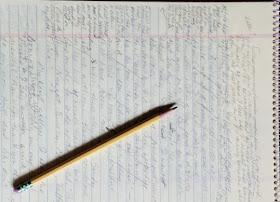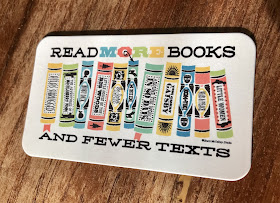Roundtable on Revision: Routines and And Cues
In Part One of our Roundtable we discussed our thoughts about how to write consistently. In Part 2 we chew on a topic that writers are always curious about. . . how to pysch yourself into revising. The GROGers have tips and tricks to make your revisions go better.
Kathy Halsey:
I write my revisions in purple and the Com San Serif font to train my mind that this is revision work. When I see purple, I know my mindset changes. I know everything can be changed.
I also use my MacBook Pro to read my revision back to me and change as I hear it aloud. On a Mac, Choose Apple menu, Go to System Preferences, then to Accessibility. Then click Spoken Content. Select the “Speak selection” checkbox. By default, your Mac speaks text when you press the keyboard shortcut. Again, see System Preferences.
Christy Mihaly:
My favorite revision tip is to give something to my critique partners! Honestly, they're brilliant. Then I just have to try to reconcile their various comments.
On my own, for picture books, doing a dummy really helps clarify where I need to revise.
I have a cool writer's tool for this: a reusable, 32-page dry-erase notebook that's great for sketching out stories. [Images attached, including one showing how I mapped out spreads for WATER: A Deep Dive of Discovery (which is 64 pages).]
Finally, when I'm stuck with a story I often find that rewriting it from another character's point of view helps get things unstuck.
Carol Coven Grannick:
I happen to love revision much more than the first draft. Re-reading, often aloud, is my door to noticing that something—I may not know what, yet—is “off”. Whether short poem or middle grade novel, I trust the “off” feeling (whether it’s from me or critiquing colleagues). And so it goes over and over, fine tuning one draft after the other until it feels right.
Sue Heavenrich:
Like Christy, I use my critique partners to help me see things that could use revision, or to help me clarify what I’m trying to say. Often I’ll print out what I’m working on and put it in my Morning Pages notebook. I might try a different structure (using rhyme instead of prose) or a different point of view. Or I might wad the whole thing up, toss it against the wall, and say: “If I had to explain this to a kid, how would I do it?” Then I write that into Morning Pages.
Some of my best ideas for writing and for revision, though, happen while I’m in the garden or turning compost or out for a walk - so I make sure to tuck an index card and pencil in my pocket when I head outside.
Suzy Leopold
The revision process is a time to bring order to my thoughts. It’s a process of discovery to reread, rewrite, rethink, review, and reconfigure the story idea to write an improved version. My stories include multiple revisions. The following are suggested tips for revision to consider:
Revising requires time, patience, and reimagination.
Read the manuscript aloud
Write a pitch or one sentence description
Create a book dummy
Be deliberate with word choices. For example: use a blue highlighter to identify active verbs versus passive verbs, pink to identify dialogue.
Read and reread mentor texts
Every writer has his/her own approach for the revision process.
Patricia Toht
My creating is done in fits and spurts, depending on how busy my day job is. But, even if I’m unable to create something new, I usually have something old that can be revised.
One part of the revision process that I love is focusing on word choice. While it might seem tedious to some, I enjoy taking one sentence at a time and examining each word. Is it necessary or superfluous? Is it the BEST word for THIS sentence? Is there an opportunity to add internal rhyme, assonance, alliteration? If I need to reduce text by a specific count, I write the number of words I'm removing (with a minus) and once in a while adding (with a plus). It's a great visual to show progress!
 |
| Four editing resources I keep at hand |
Julie Phend
Like Patricia, I love revising for word choice and sentence flow. And, like Carol, I read it aloud for the sound. I have much more trouble revising a whole novel--my first drafts are often messy muddles. What helps me the most is Martha Alderson’s plot planner. I put the plot line on a long piece of craft paper, and use sticky notes above and below the line for specific scenes. The visual really helps me see where the problems are, and the sticky notes make it easy to move scenes around.
You've seen how GROGgers get creative to make revision work, what can you add to our discussion? Give us a revision technique that works for you or one we haven't suggested in the comments. Thank you.






Oh my gosh! I love the sticky notes, Julie! And Suzy's colored highlighters, Kathy's purple crayon (pen), and Christy's dry-erase notebook. I didn't even know they made such a thing! Word choice, yes, Patricia. And Carol's "read out loud" really works.
ReplyDeleteWe got the 411.
DeleteI love these ideas—so many are new to me! I have no new ideas other than shrinking the manuscript looking for white space, and searching 🔍 for passive verbs (neither one my own idea). This is a great post to save for further reference. Thanks everyone!☺️
ReplyDeleteThanks for stopping by, Jarm.
DeleteAll great advice. I love revising my work. It (hopefully) makes it so much better than the first draft. I like the idea of highlighting the passive verbs, taking it to my critique group, and having word 'read' it to me. I don't think I did it, but recently the voice that reads my manuscript in word is a female voice. I love it! It sounds so much better than the original male voice. Sometimes I will spend hours on finding just the right word to use. I love writing and I don't think I will ever quit, though I have sometimes threatened to do so.
ReplyDeleteJanet, write on.
DeleteWonderful tricks and tips fro revising! Thank you Kathy, Christy, Carol, Sue, Suzy, Patricia, and Julie.
ReplyDeleteAww, Charlotte, thanks for being here.
DeleteGreat tips. I agree--my critique partners are key. Sorry I couldn't participate. I've been swamped.
ReplyDeleteTina, we know you have been authoring - that always comes first.
DeleteLately, when I'm revising I follow the advice of Pat Zietlow Miller when I get stuck. I articulate in writing the main message I want to convey or what I want the reader to feel; I choose 3 words that correspond to the purpose, voice and heart; and then I focus in and writing down the universal truth or universal emotion. Then I go back into the manuscript.
ReplyDeleteGreat idea, Bonnie. You can't go wrong with Pat Z. Miller.
DeleteWow, lots of great strategies! Thank you!
ReplyDeleteSuch smart ideas. Thank you. I'm always on the look out for better ways to work.
ReplyDelete